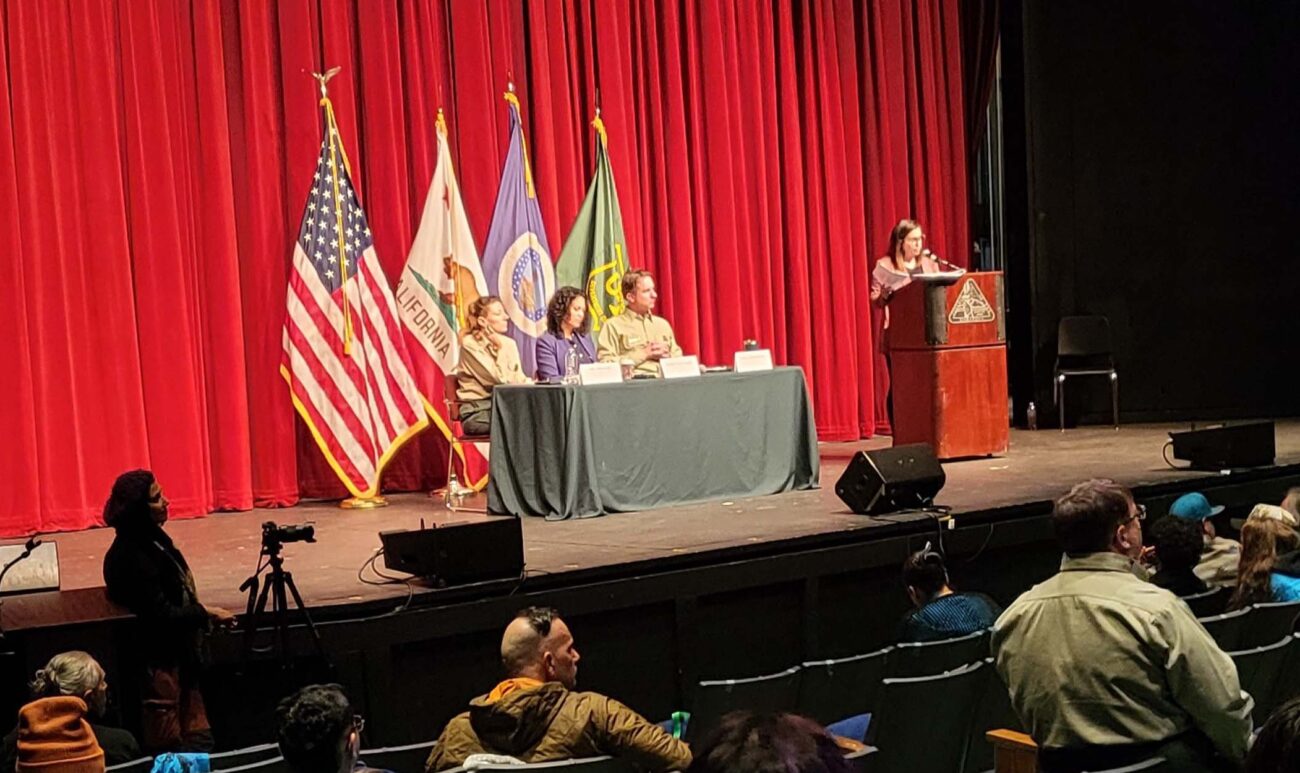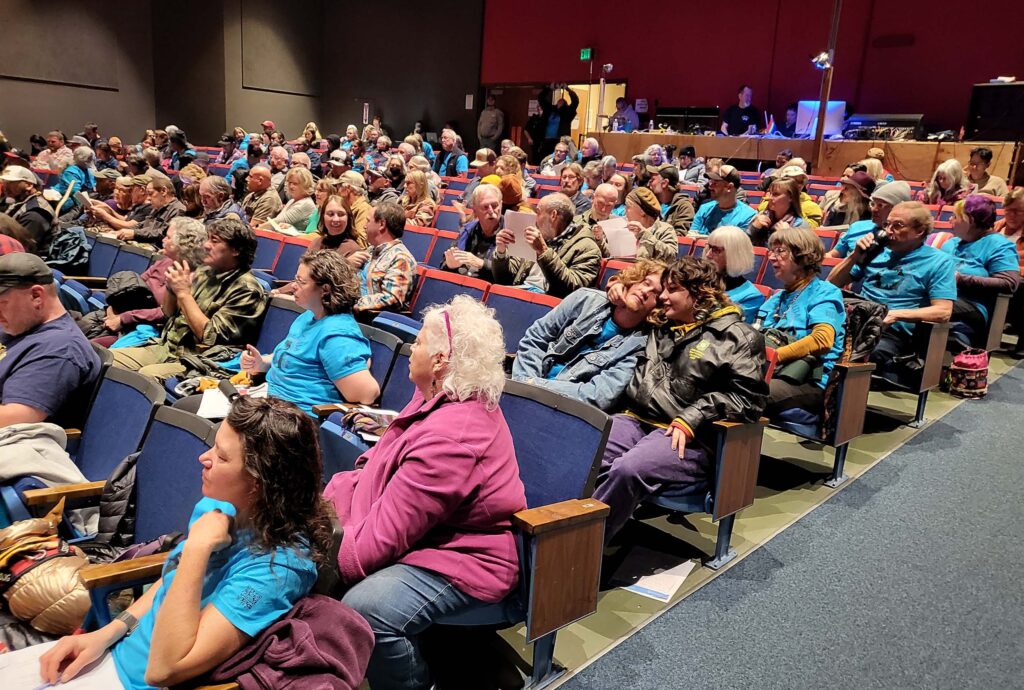
Photo taken December 7, 2024 © Doug Mandel.
Sáttítla National Monument Status Update
There was no need for organizers supporting national monument status for Sáttítla (Medicine Lake Highlands) to worry about the turnout at the December 7 public hearing. The meeting, held by the Department of Agriculture and the Klamath National Forest at the College of the Siskiyous in Weed, had a standing-room-only crowd and lasted for five hours so everyone could testify.

By far, most people in the audience were in favor of national monument status, and most were from the Pit River Tribe. Two Mt. Shasta Council Members spoke out in favor, and two Siskiyou County Supervisors spoke out against Sáttítla. Many of those opposed erroneously thought the status change would affect their opportunity to hunt or ride snowmobiles. It would not. Instead, it would eliminate any mining of lava rocks, better protect archeological sites, and, with Pit River Tribe input, it would limit logging and protect wildlife habitat.
On the day prior to the public meeting, separate meetings were held with various focus groups. Shasta Environmental Alliance (SEA) was invited to a nongovernmental organizations (NGO) meeting that was attended by about 15 NGO representatives as well as the Assistant Secretary of the Department of Interior, the Superintendent of the Klamath National Forest, and a representative for Senator Padilla. Each attendee was allowed to voice their opinions at the hour plus meeting. Separate focus-group meetings were held for elected officials and for extractive industries such as logging companies.
For the December 7 public meeting, I drove to Weed with Doug Mandel of Ghost Pine Native Plant Nursery, who wrote a letter of support for the national monument designation and spoke at the meeting, as did I. A State CNPS employee called me on our drive up to make sure I was coming; they put down my name and Doug’s as speakers so we didn’t have to wait for hours. At the meeting, I was surprised to see quite a few SEA supporters in the audience, including one man from Weaverville and three SEA board members. CNPS was there in force, with attendees including the state Executive Director Jun Bando and many staff members. The Pit River Tribe gave away free T-shirts and Indian tacos. Overall, it was a fun and uplifting experience.
This public meeting was the last step of many in developing a recommendation for National Monument status. We now have to wait to see if President Biden will establish the National Monument before his term ends; if not, it may be years before this special place will receive the protection it warrants. Thank you to all who signed petitions, wrote emails, or spoke out in support and worked on this noble effort!
BREAKING NEWS! Rumor has it that President Biden has indeed made Sáttítla a national monument!

Stop Wood Pellet Plants
Golden State Natural Resources (GSNR) is seeking approval to build the largest wood pellet production project in the country right here in our backyard. Shasta Environmental Alliance (SEA) is working with a broad coalition of environmental groups and community organizations to oppose the project, which would pose threats to our forests as well as to the health of people living near these polluting plants.
GSNR would construct and operate three facilities: two wood pellet production facilities—one in Tuolumne County and one in Nubieber in Lassen County (less than 10 miles east of Shasta County)—and a storage and shipping facility in the Port of Stockton. Together, the facilities would produce 1,000,000 megatons (MT) of wood pellets per year that would then be exported for burning in power plants overseas. The project would also authorize “wildfire resilience and forest restoration” projects on a programmatic level, which would provide over 890,000 MT of “roundwood” (wood in its natural state as felled) for the facilities each year.
The economics of these wood pellet plants is simple. In an effort to replace coal as the fuel in coal-powered electrical plants, various countries in Europe and Asia have declared that electricity produced by burning wood pellets is “clean energy.” Companies producing clean energy get special benefits in addition to the income they make from producing electricity. However, by the time forests are logged, the wood is transported to production plants, processed (chipped, ground, heated to remove moisture, and pressed into wood pellets), and shipped across the ocean, it has released 1.5 times as much CO2 as would use of coal to produce the same amount of electricity. And, the carbon-sequestering trees are now gone.
This type of logging for wood pellets in the southeastern United States has clearcut much of the private forest land, taking out the carbon in the forest, destroying habitat for wildlife, and producing a considerable amount of pollution. The British learned centuries ago that clearcutting forests to power steam locomotives with wood was inefficient, and that using coal, which burned much hotter, was much more efficient.
Companies such as Drax, which has owned many coal plants over the years, is supporting the proposed plant for Lassen County. SEA is working with many environmental groups locally, regionally, and nationally to stop the building of this plant in Lassen County. For more information, please see the Environmental Information Protection Center’s (EPIC’s) article, Donate to EPIC to Help Stop Dirty Mega-Biomass Project, and the Natural Resources Defense Council’s (NRDC’s) article, Drax Coming for California Forests by Partnering with GSNR, by Rita Vaughan Frost.
Fight climate change! Protect our forest environments!
For further conservation news and issues, please see SEA’s January 2025 Newsletter. ~David Ledger, Conservation Chair
